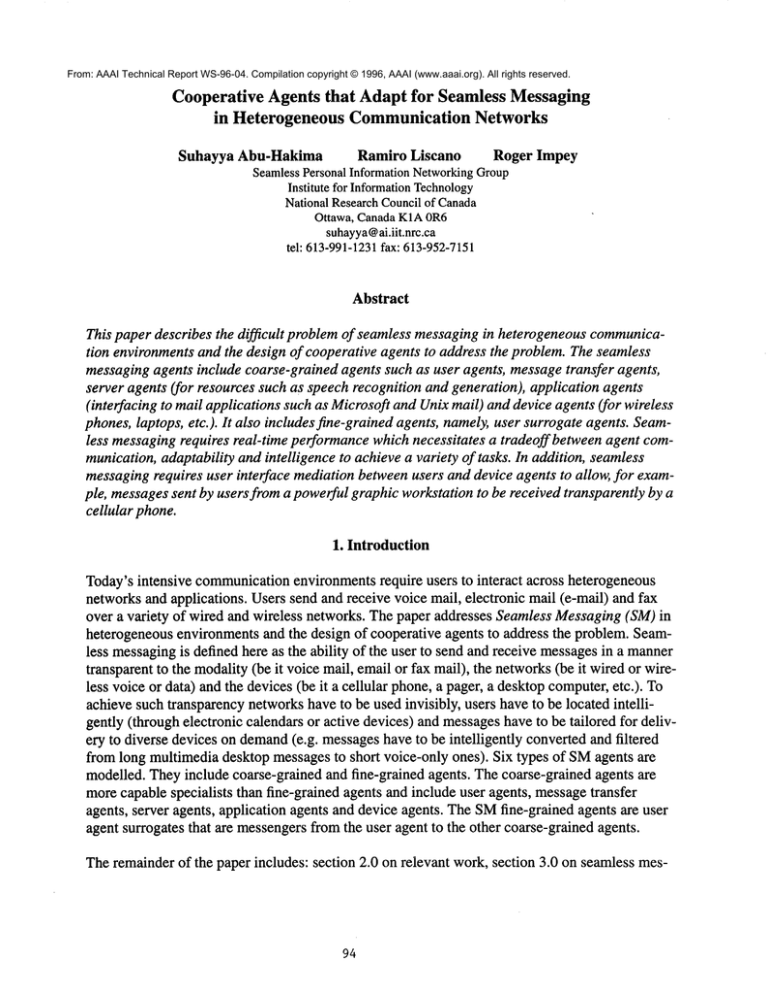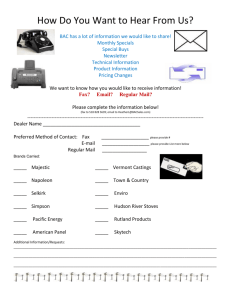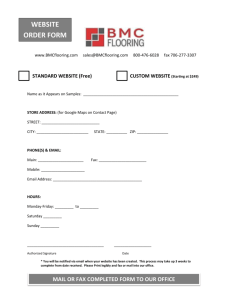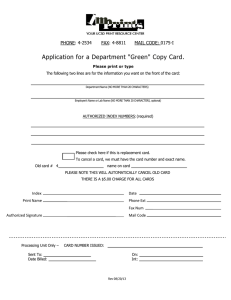
From: AAAI Technical Report WS-96-04. Compilation copyright © 1996, AAAI (www.aaai.org). All rights reserved.
Cooperative Agents that Adapt for Seamless Messaging
in Heterogeneous
Communication Networks
Suhayya Abu-Hakima
Ramiro Liscano
Roger Impey
SeamlessPersonalInformationNetworking
Group
Institute for Information
Technology
NationalResearchCouncilof Canada
Ottawa, CanadaK1A0R6
suhayya@
ai.iit.nrc.ca
tel: 613-991-1231
fax: 613-952-7151
Abstract
This paper describes the difficult problemof seamless messagingin heterogeneouscommunication environmentsand the design of cooperative agents to address the problem. The seamless
messagingagents include coarse-grained agents such as user agents, messagetransfer agents,
server agents (for resources such as speech recognition and generation), application agents
(interfacing to mail applications such as Microsoftand Unixmail) and device agents (for wireless
phones, laptops, etc.). It also includes fine-grained agents, namely,user surrogate agents. Seamless messagingrequires real-time performancewhich necessitates a tradeoff between agent communication,adaptability and intelligence to achieve a variety of tasks. In addition, seamless
messagingrequires user interface mediation betweenusers and device agents to allow, for example, messagessent by users from a powerful graphic workstation to be received transparently by a
cellular phone.
1. Introduction
Today’s intensive communicationenvironmentsrequire users to interact across heterogeneous
networksand applications. Users send and receive voice mail, electronic mail (e-mail) and fax
over a variety of wired and wireless networks. The paper addresses Seamless Messaging(SM) in
heterogeneous environmentsand the design of cooperative agents to address the problem. Seamless messagingis defined here as the ability of the user to send and receive messagesin a manner
transparent to the modality(be it voice mail, email or fax mail), the networks(be it wired or wireless voice or data) and the devices (be it a cellular phone,a pager, a desktopcomputer,etc.).
achieve such transparency networkshave to be used invisibly, users have to be located intelligently (through electronic calendars or active devices) and messageshaveto be tailored for delivery to diverse devices on demand(e.g. messageshave to be intelligently converted and filtered
from long multimediadesktop messagesto short voice-only ones). Six types of SMagents are
modelled. Theyinclude coarse-grained and fine-grained agents. The coarse-grained agents are
morecapable specialists than fine-grained agents and include user agents, messagetransfer
agents, server agents, application agents and device agents. TheSMfine-grained agents are user
agent surrogates that are messengersfrom the user agent to the other coarse-grained agents.
The remainderof the paper includes: section 2.0 on relevant work, section 3.0 on seamless mes-
94
saging agents, section 4.0 on the tradeoff betweencommunication
and agent capability, section
5.0 on user interface mediation for SMdevices, and section 6.0 on future workand conclusions.
2. Related Work
Networkscan be seen as a natural domainfor the application of distributed artificial intelligence,
and moreparticularly, agent-based computingtechnology [Reinhardt 94]. In particular, Weihmayerand Velthuijsen suggest a numberof reasons for this, including their inherent distribution
(e.g. along spatial, functional, and temporallines), the proliferation of heterogeneousdevices and
services associated with them(this is particularly true of multi-vendor mixedcomputing-communications networks), the growingneed for privacy, the sustained demandsfor high performance,
and the increasing desire for "intelligence" in the network[Weihmayer
and Velthuijsen 94].
Modellingmessagingin organization services as a collection of coordinated agents results in a
numberof benefits. For example,a degree of virtual homogeneityis brought to otherwise heterogeneous networks of computer-telephonymessagingservices and devices (such as voice mail, email or fax mail); relatedly, a moreopennetworkarchitecture facilitating morerapid and effective
deploymentof "plug and play" messagingservices is madepossible. All the same, the agent metaphor doesnot, in and of itself, directly resolve any of the technical issues related to systeminteroperability such as sharing remote resources, guaranteeinga particular quality of service or
resolving the network feature interaction problem. Rather, as Laufmannpoints out in [Laufmann
94] "the metaphorprovides a modelof coordination that addresses real-world issues of the computing and communicationsmarketplaces, and in so doing leverages the deploymentof newtechnical solutions as they becomeavailable". In this respect, the SeamlessMessagingUser, Server
and Application agents are analogous in scope and purpose to Laufmann’scoarse-grained agents
or CGAs[Laufmann 94].
These SeamlessMessaging(SM) agents, like those supported by the Carnot project’s Distributed
CommunicatingAgents (DCA)tool [Huhnset al. 93], are essentially high-performance problem
solvers which can be located anywherewithin and amongnetworkedenterprise resources. These
agents are intended to communicateand cooperate with each other, and with humanagents.
Throughthe use of modelsof other agents and resources within the enterprise, SMagents, like
DCAagents, will be able to cooperate to provide integrated and coherent management
of information in heterogeneous computing-communicationsenvironments.
The convergenceof networks and the need for personal digital assistants with embeddedagents
that interface to all the information accessible through a webof networks(Internet, WorldWide
Web,etc.) has also been cited as a key reason to develop cooperative multi-agent systems [Rosenschein and Zlotkin 94]. SMagents are being developedto enable users to share valuable messaging services such as voice and e-mail as if in a single seamlessnetworkacross a variety of devices
that include cellular phones, PDAs,wired telephones and wireless laptop computers.
The Multi-Agent NetworkArchitecture (MANA)
described in [Weiss et al. 95; Abu-Hakima
et al.
95] is designed to provide services across communicationnetworks. In someways, its objectives
are similar to those of the concepts in SeamlessMessaging.However,its agents are coarse-
95
grained agents whichare compiledat run-time and hence lack the flexibility to adapt as wouldbe
necessary in a seamless messagingenvironment. SMagents include surrogate user agents which
are fine-grained agents that are light weightspecifically designedfor reactive situated behaviour.
3. Modelling Seamless Messaging Agents
Whatis SM?
SeamlessMessagingprovides users with the capability to workfreely in distributed personal
workspaces.It allows the creation, encoding, filtering and delivery of messagesacross heterogeneous networks. Thus, users can seamlessly deliver voice or electronic mail to wireless or wired
mail environments. For example, a user can send an e-mail from a laptop computerand have it
received by a cellular phonewhichis the recipient’s currently active device. TheSMparadigm
requires that the recipient of the messagebe located throughan intelligent calendaringfacility and
the messagebe tailored to the recipient’s active device user interface. As such, SMis not an easy
endeavour.
Whyis SMimportant?
Seamless messagingallows users to work in distributed personal workspacesand have messages
created and delivered how, whenand where they wish. In today’s distributed environmentsusers
are often faced with multiple messagingenvironments(e.g. voice mail, e-mail or fax mail) that
not interworkintelligently, if at all. Theresults are that users are overwhelmed
with hundredsof
messagesin different messagingboxes. Manyof these messagesare unimportant or even considered junk mail. As a result, users are calling for methodsof seamlesslyintegrating these message
boxesand of intelligently filtering their contents.
Whyare agents essential for SM?
Agentsare active computationalentities that are persistent, can perceive, reason and act in their
environmentsand can communicatewith other agents [Huhns and Singh 95]. Agents are ideal for
applications that require someform of distributed intelligent cooperation. As such SMagents can
be clients, servers or messengersin a distributed environment.
As illustrated in Figure 1, agents can form the backboneof seamlessmessaging.Specifically, six
types of agents are required to achieve this application. Theyare user agents, user agent surrogates, messagetransfer agents, server agents, application agents and device agents. Eachof these
is describedin detail below.
SMagents require communicationmechanismsso that they mayinteract.
exchangingmessageswith a triplet of the form:
They communicateby
message(From_agent_id, To_agent_id, Body_of_message)
Thebodyof the messagecan be a script or data to be acted on by the receiving agent. Specific
examplesof its use are included with the description of user agent surrogates (the SMmessenger
agents) below.
96
Agent
UA1
/
I
\
Agent I
."
i
/ Device ~,
I Agent ~
’ DA21 /1
/
/
~I~’.UA2"’
\ /I
’///--~"
Device
Agent
/
~
/
~," Device \ /
~ Agent
~/
DA22l/
I///
~ "UA2S-urro-g--~t~e~
)
"°en’
Transfer
""J
......
/
/
...
I
/
/
/
UA1Surrogate’)
Figure 1: SeamlessMessagingAgents
3.1 User Agents
User agents (UAs) manage the user’s environment. These coarse-grained agents track user preferences in seamless messaging. This tracking can be based on the user explicitly instructing the
agent with a rule or a script for someaction. It can also result from the agent observing the user’s
actions and intelligently learning what the user is doing. For example, the agent could observe
that the user deletes all messages with the subject line including "CFP"(call for papers). The
agent could then propose to the user that it delete all CFPmessages. In this manner the UAsare
adaptive agents that are expected to learn from their environment.
User profiles
include rules on how to managethe messaging inbox of voice, e-mall and fax. They
97
mayalso include scripts for priority messages(e.g. "locate meurgently if the messageis from my
boss Ed"). The UAmayalso include scripts on howto handle specific messagetypes. For example, a fax messagewouldtrigger a user agent surrogate to interact with the server that includes the
optical character recognition (OCR)software. Oncethe fax is converted to an e-mail message,
can then be interpreted for priority or action (e.g. deletion, filing or forwarding).
In addition, UAsmayinclude calendar coordination information. Thus, if an urgent message
arrives, a UAsurrogate interacts with the Calendarapplication agent to get a best guess on where
the user is expectedto be. This informationis combinedwith the latest active device information
polled from the user’s DeviceAgentsto attempt to deliver the message.
3.2 User Agent Surrogates
TheUASurrogates act as messengersor intermediaries of the UAand are given specific tasks.
Theyare given scripts that direct themto other agents with specific goals. TheseUAsurrogates
are mobile and travel across networksin response to UArequests. Thesefine-grained agents are
aimed at supporting wireless PCS(personal communicationsystems) messagingwhich interacts
with mobility devices such as PDAs,cellular phones, wireless laptops and pagers.
As the user creates a message,the UAsurrogate carries it to the MessageTransfer Agent (MTA)
which examineswhothe recipient is.The MTA
identifies the recipient UAand the recipient UA
sends a surrogate to take delivery of the message.If the messageis in a format that is unacceptable to the UA,a UAsurrogate is sent to the Application Agent (AA)with the messagerequiring
translation. Users are assumedto be active on mobiledevices (e.g. a cellular phone), stationary
devices (e.g. a Sun workstation) or a combination. The user DeviceAgents (DAs)track
activity and are ready to report status to the UAon demand.
For examplein figure 1, UA1 mayhave sent a Microsoft mail messageto UA2.The MTA
informs
UA2of the messageusing the following communicationscheme:
message(MTA_id, UA2_id, Incoming_message)
UA2sends its surrogate to receive the message. After UA2receives the message,it recognizes
from the MTA
tag that it is a Microsoft e-mail. UA2then sends another surrogate to AAto have
the messagetranslated to Unix mail. The communicationwould be:
message(UA2_id,AA_id,[Script[translate_email(Microsoft_m, to, Unix_m)]]))
The"Microsoft_m"variable is actually the file that is to be convertedto Unixand returned by
binding it to the "Unix_m"variable. Furthermore, AAacts as a gatewaybetweenthe two environmentsand translates any attachments as instructed by the UA2surrogate on what file formats its
user can accept.
Anotherpossibility is that UA1sends UA2a voice messagethat is tagged as urgent. UA2polls its
devicesand finds that its user is at a text-only device. It then triggers a surrogateto interact with
the Server Agentto have the voice messagerecognized by a speech recognizer. The text of the
voice messageis then received by the UA2surrogate and delivered to the active device.
98
Yet another possibility is for UA1 to have sent UA2an e-mail that is tagged urgent. Again, UA2
polls the device agents and finds its user only active on the cellular phone. AUA2surrogate asks
the server agent to generate speechfrom the text. This digitized speechis then transmitted to
UA2’scellular phonedevice agent for playbackto the user. Note that if the e-mail is too long,
UA2wouldhaveto first send the messageto an AAspecialist to filter the text to its key concepts.
3.3 Message Transfer Agents
MessageTransfer Agents (MTAs)mediate inthe delivery of messages between heterogeneous
systems. These coarse-grained agents receive messagesfrom the UAsand interpret the header
information. The interpretation is then transmitted to the recipient UAsurrogate. Thus, messages
¯ are tagged with a type (voice, e-mail or fax) and in somecases (e-mail) with a subtype. The
type indicates the e-mail environmentthe messagewascreated in (e.g. Unixmail or Microsoft
mail). MTAs
are similar in function to the MTAs
proposed in the X.400messagingstandards.
3.4 Server Agents
Server Agents(SAs) are coarse-grained agents that mediate in the performanceof a specialized
function. Specialities in messaginginclude speech recognition (for voice to e-mail conversion),
speechgeneration (for converting e-mail to voice), and fax optical character recognition (for converting fax to e-mail).
Server agents mayalso provide a seamless interface for hopping betweennetworks. This is a key
requirement in movingbetweenpublic networksfor wired or wireless voice and data. In most private networks movementbetween voice and data can be achieved locally. This will be madeeasier with the advent of voice cards and telephony interfaces that will reside in workstations and
laptops.
3.5 Application agents
Application Agents (AAs) are coarse-grained agents that mediate betweenUAsurrogates and end
user applications such as mail (e.g. Microsoftmail, Unixmail, Eudora,etc.) and calendaring.
Theyenable UAsurrogates to translate betweenmail environments and encode attachments as
needed. Theyalso allow UAsurrogates to query electronic calendars that maybe directly incompatible.
Application Agentsmayalso provide an interface to specialized applications. Filtering of message content is such an application. Suchfiltering mayallow the distillation of pages to a set of
specific concepts. Aprimitive formof mail filtering occurs at the UAlevel whererules and scripts
are triggered based on the messageheader that includes the sender and the subject. However,filtering out the concepts rather than only the keywordsin a messageis a moresophisticated speciality that is ideal for an AA.
Anotherspecialized application is people finding. Here, a combinationof calendar and active
device informationcan be used to isolate users. Thusfar, active device informationhas only been
used successfully to find people [Fergusonand Davlouros95].
99
3.6 Device Agents
DeviceAgents (DAs)reside in the devices that a user receives messageswith. DAsinclude a cellular phone, a PDA,a laptop, a telephone, a workstation or a fax. DAsinteract with UAsand may
share the physical device with a UA(e.g. a workstation). DAscan be groupedinto either personal
(ownedby an individual) or public (shared by several users) devices. For example,a cellular
phone or a laptop maybe a personal device whereas a workstation maybe shared.
Deviceagents are coarse-grained and they have two key roles. Theymaintain a log of activity by
the user so that they mayrespond to UAsurrogates polling for active devices. Theymoreimportantly interact with the UAand the UAsurrogates to create, send and receive messages. The UA
surrogates interact with the Application Agentsand the DAsas the user creates the messages.
4. Tradeoff Between Communicationand Compilation in Seamless Messaging Agents
SeamlessMessagingrequires realtime performance.This is whyit is essential for this distributed
application to take advantageof agents that naturally partition the application. TheSMspecialists
(such as the server and application agents) are called on whennecessary by the UAsurrogates
with specific goals.
The SeamlessMessagingagents mix coarse and fine-grained agents to take advantage of the
tradeoff betweencommunicationand specialization. In the MANA
agents [Weiss et al. 95],
coarse-grained agents are programmed
with pre-compiledscripts. To changethe agent, it is necessary to take it off line and redefine its script and then re-compileit. This is unacceptablein any
dynamicevolving application such as SMwhere the agent environmentcannot be assumedto
remainstatic.
SMagents by definition have a higher degree of communicationso that they maycoordinate their
activities. Theycommunicate
their intentions, goals, results and state in the form of the message
triplets describedearlier. Themessagesmayincorporatestatus, scripts (e.g. for goals or queries to
the receiving agent). SMagents communicatemore, thus raising the cost of performance. However, the UAsare adaptive and their functionality is expectedto evolve with user preferences.
5. User Interface Mediation in Seamless Messaging
Mediatingbetweenthe different user interfaces of the devices used in seamlessmessagingis a
difficult problem.As illustrated in figure 2, this includes mediatingbetweenmessagesreceived on
a full-screen (e.g. a 19 inch layout) workstationand a wireless phone(e.g. a 2 line character display). This is compounded
by the preference of users for heterogeneous messagingapplications
that include a variety of e-mail applications, voice messagingand fax. This is even mademore
complexby mediating across wired and wireless networkswhich have differing user characteristics including noisy reception and high error rates in wireless networks.
ioo
0
i
v
J456
I 789
J *0#
L
k,x
/J
Figure2: Required
UserInterfaceMediation
in SeamlessMessaging
In SeamlessMessagingthis can be addressed somewhatthrough the use of preferences in user
agents. A user agent profile could include layout and modalitypreferences, i.e. "alwaystry and
deliver to mylaptop versus mycellular phone"and "do not convert voice mail from a cellular
phoneto text, just deliver it as digitized voice over the laptop speaker". Thesedo not haveto be
madeexplicit by the user but mayinclude defaults that are reasonable in cooperating between
humansand their devices. Aset of heuristics maybe encodedin all user profiles that incorporates
someof the key aesthetics and general usability factors in SM.
Deviceagents, messagetransfer agents and application agents can also help mediate betweenthe
conflicting user interface requirements. In the earlier example,the MTA
was used to inform the
user that an e-mail messagetargeted to themis not in the format of their mall environment.The
messagewasthen translated by an application agent. Thedevice agent for a cellular phone could
refuse to accept a text messagethat exceedsits buffer size thus avoidingthe delivery of a long email to a cellular phone. However,the UAhas to be intelligent enoughto ask the mail filtering
specialist to distil the long e-mail to the key conceptsso that an urgent e-mail can still be delivered to the cellular phone.
Thus, to attempt to meet user interface mediation requirements in seamless messagingone
requires:
¯ user agent default and customizableprofiles to include delivery and modalitypreferences
¯ device agents must include the ability to bouncemessagesback to UAsurrogates based on
logistic (e.g. pagesof text to be delivered to a 2 line cellular phone)incompatibilities
¯ device agents must also include the ability to mediateconflicting modalities (e.g. delivering
voice to a device that cannotprocess it returns an error to the UAthat requests the text equivalent of the voice)
IOI
messagetransfer agents must identify the content and required delivery mediumof a message
and transmit this information to the recipient’s UAsurrogate. TheUAsurrogate must then isolate the active device of the user and wait for instruction fromthe recipient UA.Therecipient
UAwill then instruct the surrogate to have the messageconverted to text or voice as the context dictates.
6. Future Workand Conclusions
The SeamlessMessagingapplication is currently being implementedwith a combination of tools
such as Lotus Notes, PhoneNotes and Netscape. A UAmail filter has been implementedin Netscape and Lotus Notes. Furthermore, a prototype integrating email and voice mail preferences
with user directed action for filtering has been implementedin Lotus Notes. A full implementation that wouldinclude messagingbetweena variety of e-mail environmentsand voice mail is
expected to be completedin an 12 monthtimeframe.
Adaptability is an essential characteristic of the SMagents. Threeforms have been described in
the paper. The first mechanism
requires the user agents to observe what the user does with their
messages(be they voice, email or fax). Basedon these observations, action scripts will be generated and sent to the user for approval on actions to be taken for incomingmessages.The second
mechanism
is the filtering of messagecontent so that messagesmaybe delivered to a very different device than the one where the messageoriginated (e.g. a long multimediadesktop message
has to be decomposed
and filtered so that a short equivalent can be delivered to a cellular phone).
Thethird adaptability mechanismdeals with the assumptionthat the user is mobile and must be
located for urgent messages.Theuser is located using a combinationof electronic calendaring
informationand latest active device information.
This paper has described the difficult problemof seamless messagingin heterogeneous communication environmentsand the design of cooperative agents to address the problem. The seamless
messagingagents include coarse-grained and fine-grained agents. Seamlessmessagingrequires
real-time performancewhich necessitates a tradeoff betweenagent communication,adaptability
and intelligence to achieve a variety of tasks. UserAgentSurrogates are the fine-grained agents
used to lighten the communicationload betweenthe User and Device Agents and the distributed
specialist agents such as the Server, Application and MessageTransfer agents. User interface
mediation betweenusers and device agents is also being studied to enhancethe implementation.
References
[Abu-Hakima
et al. 95] S. Abu-Hakima,I. Ferguson, N. Stonelake, E. Bijman, and R. Deadman.
A Help Desk Application for Sharing Resources Across High Speed Networks Using a MultiAgent architecture. Proceedings of the workshopon AI in Distributed Information Networks,
IJCAI-95,Montreal, Quebec,August19, 1995. pp. 1-9. (available from editorial@ai.iit.nrc.ca)
[Ferguson and Davlouros 95] I. Ferguson and J. Davlouros, On Establishing Multi-Sensory
Multi-Channel CommunicationsAmongNetworkedUsers. Proceedings of the workshop on AI in
Distributed Information Networks,IJCAI-95, Montreal, Quebec,August19, 1995. pp. 1-9. (available fromeditorial@ai.iit.nrc.ca)
102
[Grayet al. 94] T. Gray, E. Peres, D. Pinard, S. Abu-Hakima,
A. Diaz, and I. Ferguson. AMultiAgent Architecture for Enterprise Applications. In WorkingNotes AAAI-94Workshopon Artificial Intelligence in Business Process Re-engineering, Seattle WA,July 1994, pp. 65-72. NRC
37140.
[Hubris and Singh 95] M.N. Huhns, and M.P. Singh, Cooperative Information Systems, IJCAI95 tutorial Notes, August21, 1995, Montreal, Quebec,Canada, 68 pages. Published by IJCAI.
[Huhnset al. 93] M.N.Huhns,N. Jacobs, T. Ksiezyk, W. Shen, M.Singh, and P.E. Cannata. Integrating Enterprise Information Modelsin Carnot. In Proceedingsof the First International Conference on Intelligent and Cooperative Information Systems, 1993.
[Laufrnann 94] Laufmann,S. The Information Marketplace: The Challenge of Information Commerce. In Proc. of the Second International Conference on Cooperative Information Systems,
May, 1994, pp. 147-157.
[Reinhardt94] A. Reinhardt. The Networkwith Smarts. Byte, October, 1994 pp. 51-64.
[Rosensehein and Zlotkin 94] J.S. Rosenschein and G. Zlotkin. Designing Conventions for
AutomatedNegotiation. AI Magazine15(3), 1994, pp. 29-46.
[Weihmayerand Velthuijsen 94] R. Weihmayerand H. Velthuijsen. Application of Distributed
AI and Cooperative ProblemSolving to Telecommunications.In Proc. of the International Workshop on Distributed Artificial Intelligence, LakeQuinault WA,July 1994.
[Weiss et al. 95] M. Weiss, T. Gray, and A. Diaz. A Multi-agent Architecture for Networking
Applications. Submitted to First International Conferenceon Multiagent Systems, San Francisco
CA, June, 1995.
103



